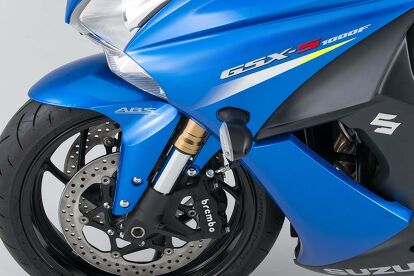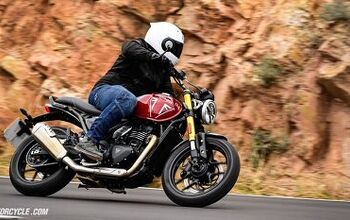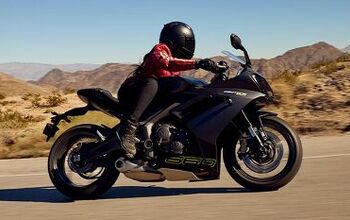2016 Suzuki GSX-S1000, GSX-S1000F, and GSX-S1000F ABS Preview

Shedding track focus for street dominance
Although the primary focus of the Suzuki Dealer Meeting is the revealing of the 2015 model line, a special look a year ahead was shared with attendees in the form of the early-release 2016 GSX-S1000, GSX-S1000F, and GSX-S1000F ABS models. Suzuki is well aware that some of the qualities that make an open-class sportbike capable of winning on the race track prevent it from being an ideal street bike. To remedy this issue, today Suzuki introduced its dealers and the media to the GSX-S1000 line of motorcycles.
Instead of looking to the current generation GSX-R1000 engine for the S1000’s powerplant, Suzuki’s engineers reached back a few years and plucked the 2005–2008 generation GSX-R1000 engine and its more midrange-focused power delivery to propel the GSX-S1000.
Using a longer stroke, cylinder dimensions of 73.4 mm x 59 mm (compared to the current generation’s 74.5 mm x 57.3 mm) broadens the torque output from the 999cc engine. Cylinders are fed by 10-hole injectors and the Suzuki Dual Throttle Valve (SDTV) system to deliver the appropriate fuel mixture for the riding condition. The inclusion of iridium spark plugs improves combustion thanks to their hotter spark. The way the power is put to the ground can be altered by the three rider-selectable traction-control settings (plus off).
Discuss this at our Suzuki GSX-S1000 Forum.
Further engine details include a four-into-two-into-one exhaust system that exits via a triangular muffler. Most of the system resides under the engine with the stubby muffler poking out low in the chassis by the swingarm. The curved radiator gives maximum cooling without adding to the width of the motorcycle. New push-to-start technology that is becoming common in the automobile industry makes its appearance on the GSX-S1000 line, alleviating the rider’s need to hold down the starter button until the engine fires. Instead, the button is pushed and released while the motorcycle takes care of the rest.
The all-new, twin-spar aluminum frame provides the platform to hang the engine and all the rolling components. It also contributes to the 32.0 in. seat height which Suzuki claims is the lowest in its class. (A quick look at our 2014 Ultimate Streetfighter Smackdown ( Part 1 and Part 2) bears this claim out.). Suspension duties are handled by a fully-adjustable KYB inverted fork and a fully-adjustable link-type shock. Cast aluminum six-spoke wheels sport 120/70-ZR17 and 190/50-ZR17 Dunlop tires. Braking duties are handled by radial-mount Brembo monoblock calipers. Rotor size is unknown at press time. The ABS model will receive a Bosch ABS system.
The riding position is upright and street-focused. As with the S1000’s little sister, the GSX-S750, a Renthal aluminum Fatbar will give the rider plenty of leverage while damping vibration. The LCD instrument cluster features all the necessities and then some: speedometer, tachometer, odometer, dual tripmeters, clock, water temperature gauge, gear-position indicator, and average and instant fuel consumption.
The three versions of the GSX-S1000 line aim to give open class riders the style and performance they require. The GSX-S1000F differs from the standard, naked version solely in the full fairing and its additional wind protection for the rider. The GSX-S1000F ABS, obviously, provides the additional security of ABS to the faired model. All three models will have the color options of Metallic Triton Blue, Glass Sparkle Black / Candy Daring Red and Metallic Matte Fibroin Gray.
As exciting as these machines are, fans of open-class sportbikes will just have to cool their jets for a little while. Although the GSX-S1000 family will be an early release 2016 model, it’s still a 2016 model and will be set loose on the riding public sometime – at a to be determined date – after the 2015 models are on the streets. Color us excited …
2016 Suzuki GSX-S1000 & GSX-S1000F, GSX-S1000F ABS Specifications
| Engine type | Four-stroke, liquid-cooled, DOHC, inline-Four |
| Engine displacement | 999cc |
| Bore x stroke | 73.4mm x 59mm |
| Fuel system | Suzuki Fuel injection |
| Compression ratio | 12.2:1 |
| Ignition system | Electronic ignition |
| Transmission | 6-speed constant mesh |
| Overall Length | 2,115mm (83.2 in.) |
| Overall Width | 795mm (31.3 in.) |
| Overall Height | 1,080mm (42.5 in.) |
| Wheelbase | TBA |
| Ground clearance | 140mm (5.5 in.) |
| Seat height | 815mm (32.0 in.) |
| Curb mass | TBA |
| Suspension, Front | Inverted telescopic, coil spring, oil damped |
| Suspension, Rear | Link type, coil spring, oil damped |
| Brakes, Front | Disc brake, twin |
| Brakes, Rear | Disc brake |
| Tires, Front | 120/70-ZR17M/C (58W) tubeless |
| Tires, Rear | 190/50-ZR17M/C (73W) tubeless |
| Fuel tank capacity | 17 L (4.5 U.S. gal.) |
| Colors | Metallic Triton Blue |

Like most of the best happenings in his life, Evans stumbled into his motojournalism career. While on his way to a planned life in academia, he applied for a job at a motorcycle magazine, thinking he’d get the opportunity to write some freelance articles. Instead, he was offered a full-time job in which he discovered he could actually get paid to ride other people’s motorcycles – and he’s never looked back. Over the 25 years he’s been in the motorcycle industry, Evans has written two books, 101 Sportbike Performance Projects and How to Modify Your Metric Cruiser, and has ridden just about every production motorcycle manufactured. Evans has a deep love of motorcycles and believes they are a force for good in the world.
More by Evans Brasfield









































































































Comments
Join the conversation
Definitely better looking than z1000. Idk if its enough for me to replace my Honda 919 though.
The faired version will compete with the Ninja 1000, but without built-in luggage mounts and inadequate space for a companion. I guess it will come down to price and how well the engine performs.